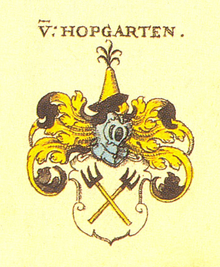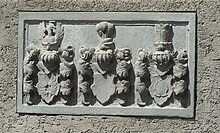Hopffgarten
Hopffgarten (later also Hopfgarten ) is the name of a widely ramified old Thuringian noble family .
history
A castle site in the village of the same name in Hopfgarten in the Thuringian district of Weimarer Land lies in the lowland of the Gramme and is considered the ancestral seat of the Lords of Hopfgarten, named from 1247. The first documented member of the family is Siffrid de Hoppengarten , who first appeared in 1262, with whom the family line also began . The castle is said to have been destroyed as early as 1303 during the war between Erfurt and Landgrave Albrecht .
The family, acting as landgrave followers, was then apparently compensated with goods in the Schlotheim and Mülverstedt area . In 1425 Friedrich von Hopfgarten bought the town and castle Schlotheim from Count Heinrich von Schwarzburg. The Lords of Hopfgarten formed a manorial and judicial district in this area on the Hainich and east of the Hörselberge . Schlotheim belonged to Schwarzburg-Sondershausen from 1571 and to Schwarzburg-Rudolstadt from 1599 .
In 1768 Maximilian Ernst von Hopffgarten had Schlotheim Castle demolished and a Baroque palace built in its place from 1773–1777. Georg Wilhelm von Hopffgarten was on 31 July 1790 in the Saxon kingdom of Vicariate in the imperial counts charged. The count's line in the male line expired in 1944 .
People and data
- In 1262, Siegfried von Hopffgarten witnessed when Margrave Albrecht von Landsberg allowed the Crantschwitz Monastery to buy 1,000 fiefdoms from its subjects.
- In 1267 Dominus Sigfridus de Hopffgarten was a witness when Landgrave Albrecht the Naughty (that's the aforementioned) confirmed the foundation of the Catholic altar in the Neustadt (?) Weida church .
- In 1280 Siegfried von Hopffgarten was a witness when Landgrave Albrecht confirmed the possession of the churches in Plaue and Gera to the Teutonic Order .
- 1316 Albert von Hopffgarten mediates, among other things, a comparison between Count Hermann IV von Gleichen († 1343) and the monastery in Erfurt .
- In 1425 Friedrich von Hopffgarten bought the castle and town of Schlotheim from Count Heinrich (XXVI.?) Von Schwarzburg .
- Friedrich von Hopfgarten appeared for the first time in connection with Haineck Castle around 1425 , he became a co-owner of this castle for an amount of thousand marks, but had to accept that it was still inhabited by a landgrave bailiff. Ownership was lost as early as 1437 when it had to be redeemed as a pledge for a payment obligation. Finally, in 1503, the castle came back into the hands of the family, who kept it with a short interruption until 1945. Around 1550 they built the Nazza Castle nearby , which they sold in 1816. The area around Hallungen became the Hopffgarten court .
- In 1440 the Lords of Hopffgarten sold Krayenburg Castle near Tiefenort to Counts Adolf and Siegmund von Gleichen.
- In 1463, the brothers Peter and Fritzsche von Hopfgarten were named in a loan letter from Count Johann von Beichlingen about part of Marolterode and the entitlement of the brothers Dietrich and Jürgen von Hopfgarten was documented.
- In 1516 Rudolf von Hopffgarten was named as an arbitrator.
- In 1773 Maximilian Ernst von Hopffgarten built the baroque Schlotheim Palace .
In addition to Nazza with Haineck Castle , the family appeared as a noble landlord and court lord in the towns of Craula , Ebenshausen , Frankenroda , Hallungen , Lauterbach , Neukirchen as well as in Mülverstedt , Mechterstädt , Ebenheim , Weingarten and Burla . In 1714 the Lords of Teutleben sold the village of Laucha to Georg Friedrich von Hopfgarten. The possessions in the Duchy of Saxony-Gotha formed the " Hopffgarten Court ".
Until 1790, Friedrich Wilhelm von Hopfgarten was the electoral Saxon chief forest master in the Grillenburg hunting lodge , in the middle of the Tharandt Forest near Dresden , where a keystone from 1779 with his initials can still be found in the courtyard.
In the registration book of the Dobbertin Monastery there are two entries by the daughters of the family of the Hofjägermeister von Hopffgarten from Gustävel from the years 1790 to 1805 for inclusion in the noble women's monastery there . The coat of arms of Susanne Sophie Charlotte Elisabeth von Hopffgarten, who died on June 8, 1870 in Dobbertin, with the alliance coat of arms hang on the nuns gallery in the monastery church .
Name bearer

Line from Hopffgarten (Mülverstedt)
- Siegried von Hopffgarten appears in Mülverstedt from 1262
- Hans Ernst von Hopffgarten dies in 1757 and leaves behind no son. The von Hopffgarten family went into three parts until the widow of Hans Ernst had a son, Friedrich Wilhelm Gottlieb von Hopffgarten (born September 19, 1757), who became the sole heir to Burg Haineck, Zimmer and Mülverstedt. He was poisoned by his uncle on May 9, 1767.
- Carl Gottlob von Hopffgarten († 1765), cathedral dean
- Friedrich Abraham von Hopffgarten (1702–1774), Electoral Saxon Privy Councilor and Provost of the Naumburg Monastery
- August Gottlob von Hopffgarten († 1776), court lord of the Electorate of Saxony, justice and canon
- The writer Ellenora von Hopfgarten (1874-?), Daughter of the castle owner Baron Max von Hopffgarten, lived in Mülverstedt at the turn of the century . The author published her historical stories and poems under the pseudonym Ella von Haineck .
Line "from Hopffgarten to Haineck to Nazza"
- Georg von Hopffgarten , knight of the Order of Malta , privy councilor and bailiff of the Haineck , was the progenitor of the branch from Hopfgarten to Haineck zu Nazza.
- Georg Christoph von Hopffgarten was married to Elisabeth von Greußen . He built the local renaissance castle in Nazza.
- Georg Wilhelm von Hopffgarten , son of Georg Christoph von Hopffgarten , was married twice. He arranged for the further beautification of the Nazza Castle, which shows his alliance coat of arms.
- Hans Ernst von Hopffgarten (1671-1717), was lieutenant colonel of the Duke of Saxe-Gotha-Altenburg in the bodyguard to Gotha married and was with Deborah gold field.
- Wilhelm Heinrich von Hopfgarten was the owner of the Haineck castle ruins until 1945.
Line from Hopffgarten (Schlotheim)
- In 1425 Friedrich von Hopffgarten bought the castle and town of Schlotheim from Count Heinrich von Schwarzburg.
Other well-known namesake
- Elise von Hopffgarten , b. Enoch (1869-?), Writer
- Hans-Joachim von Hopffgarten (1915–2000), officer, most recently lieutenant general in the Bundeswehr
coat of arms
- The family coat of arms shows two upwardly diagonally crossed three-pronged gold battle forks on black handles in silver. On the helmet with black and gold covers, a black topped golden pointed hat, studded with five black feathers.
- The coat of arms of the Schlotheim tribe shows two upwardly obliquely crossed three-pronged silver battle forks on black handles in gold. On the helmet with black and gold covers, five alternating black and gold ostrich feathers.
literature
- Johann Samuelersch, Johann Gottfried Gruber et al: Allgemeine Encyklopädie ... Volume 2 . FA Brockhaus, Leipzig 1833, p. 419-424 . as a digitized version
- Georg August Galetti: History and description of the Duchy of Gotha . Third part. Gotha 1780, Hopfgartensche and some other courts around it, p. 161 ff .
- Rainer Lämmerhirt: The forgotten Hopffgarten palace at Nazza . In: Mihla municipal administration (ed.): WERRATAL news . Number 13. Verlag und Druck Linus Wittich KG, Fritzlar 2009, p. 18-19 .
- Genealogisches Handbuch des Adels , Adelslexikon Volume V, Volume 84 of the complete series, pages 352-353, CA Starke Verlag , Limburg (Lahn) 1984, ISSN 0435-2408
Individual evidence
- ^ Document book of the bailiffs von Weida, Gera and Plauen 1, Berthold Schmidt, Jena 1855, page 65, no. 124
- ↑ Michael Köhler: "Hopfgarten" - Thuringian castles and fortified prehistoric and early historical living spaces . Jenzig-Verlag, Jena 2001, ISBN 3-910141-43-9 , p. 142 .
- ^ Genealogical Handbook, Volume GA IV, page 214
- ^ Lehnbrief dated May 26, 1463, in "Lehnbriefe der Familie von Hopfgarten", in the Thuringia archives portal [accessed on February 27, 2017]
- ↑ a b Website of the Mülverstedt community
- ^ Rainer Lämmerhirt: The act of "Hanns Henning Harseim" (story by the writer E. von Hopffgarten) . In: Mihla municipal administration (ed.): WERRATAL news . Number 52/53. Publishing and printing Linus Wittich KG, Fritzlar 1992, p. 7 .



